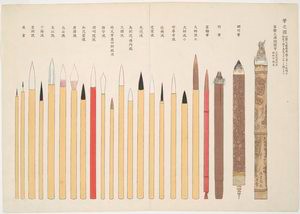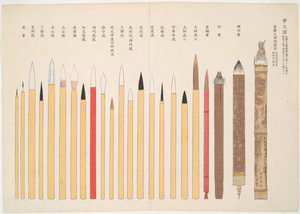
The New York Public Library. “An illustration of writing brushes.” The New York Public Library Digital Collections. Meiji 41 [1908]. http://digitalcollections.nypl.org/items/510d47d9-83a5-a3d9-e040-e00a18064a99
This project has the potential to speak to a range of audiences. The network graphs will allow researchers to see connections across collections without doing keyword searches on the finding aids database. The inquiry around how archivists arrange and describe collections in finding aids, as well as the project’s focus on interpersonal connections between writers and artists, collectors, and curators may help humanities scholars who call upon these collections to understand the institutional context that surrounds them.
By making the institutional archive the object of inquiry, I hope to also come into conversation with critical library conversations about access, power, race, and information literacy, more broadly.
The data source for this project is finding aids themselves. Therefore, the data is determined by the way the archivist processes and describes the collections. For instance, More Product, Less Process, directs archivists to make a priority of the amount of collections processed rather than the detailed processing and description. Archivists may categorize the correspondence series by date rather than by name of correspondent, which is a more “objective” practice because it wouldn’t neglect to name less important letter writers by lumping them in “Other A-K”), but it also means that the names of correspondents are not in the finding aid for researchers to find by keyword search, or available to be tagged for the dataset of this project.
The data set is also defined by the collections that have been accepted by the Rose Library, and in some cases, acquired and valued at a certain amount. This is not a broad survey of African American twentieth century culture. It is, however, a portrait of a collecting strength. An area that the Rose Library has committed to collecting in for the past 30 years (?). The collections at the Rose Library tend to be interrelated–a sign not only of a curator’s interests and what makes a good, coherent collection, but also a sign of the histories and relationships that surround the collections. A collector who is also an artist who also writes about other artists and is friends with other artists. A writer who was friends with another writer who became friends with the curator. And so on.
Plans
Inspired by new year’s resolution season, and all that research on habit-forming that’s circulating,* I’m going to set an agenda for myself at work. Each day for two hours, 11am to 1pm, I’m going to work on my Portrait of a Collecting Strength project.** I’ll turn off everything but this text editor and focus on writing about the project. (Maybe sometimes I’ll have Gephi or some related articles open too–but no email, social media browsing, or active researching.)
Relatedly, I’m going to translate my project plan into two-week chunks of themes, questions, or issues to focus on.
(This is inspired by the sew-er Christine Haynes who is doing a multi-month project based on Colette Pattern’s Wardrobe Architect series. My initial response when looking at her schedule was impatience–why wait two weeks before the next post? But upon reflection, I was convinced the spacing was wise. While my own impulse is to underestimate how much time a task takes, or how much I can get done in a period of time, I am going to follow her lead, and pace my writing goals out across bi-weekly sections.)
1: Documenting the data (January 11-22)
2: History of African American Archives in the US (January 25-February 5)
3: African Americanist Curators at Emory (February 8-February 19)
4: Correspondence networks (Febrary 22-March 4)
5: Network analysis & methodologies (March 14-25)
6: Overrepresented individuals (March 28-April 8)
7: Periodical networks & inscription networks (April 11-April 22)
8: Network analysis as entry into archives (as finding aid) (April 25-May 6)
9: Visualizations & accessibility (May 9-May 20)
10: Interconnected Collections, Provenance, and Friendship (May 23-June 3)
11: Dismantling whiteness/ Af Am Archives at white institutions (June 6-June 17)
12: Questions the project can, cannot, could go on to answer (June 20-July 1)
I’ll aim to publish a short blog post each second Friday, and I may experiment with using twitter at the start and end of each session to create a sense of public accountability (maybe calling out to the #acwri or #amwriting communities).
- I also resolve to read William Davies’ The Happiness Industry as a counterbalance to the bed-making, decluttering, breakfast-eating, meditating, regularly-exercising, leisure-reading, crafty fantasy I may be falling prey to. Also reading this Gramsci quote on dates:
Gramsci wasn't feeling New Year's Day. #everynightisnewyearseve https://t.co/Q79043Licb pic.twitter.com/ZsAu5syXs7
— Kate Crawford (@katecrawford) January 1, 2016
** I am on the reading room desk during these hours on Wednesday, so I’ll split them up: 9:30-10:30 am and 3:30-4:30 pm.

Leave a Reply